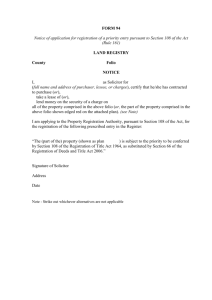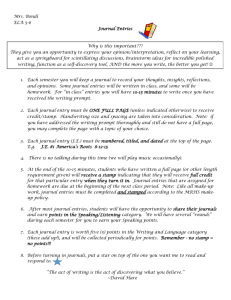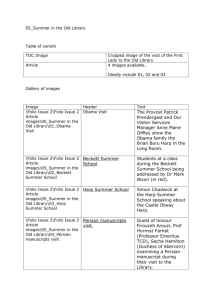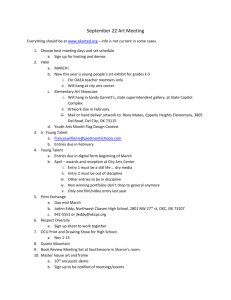General Journal
advertisement
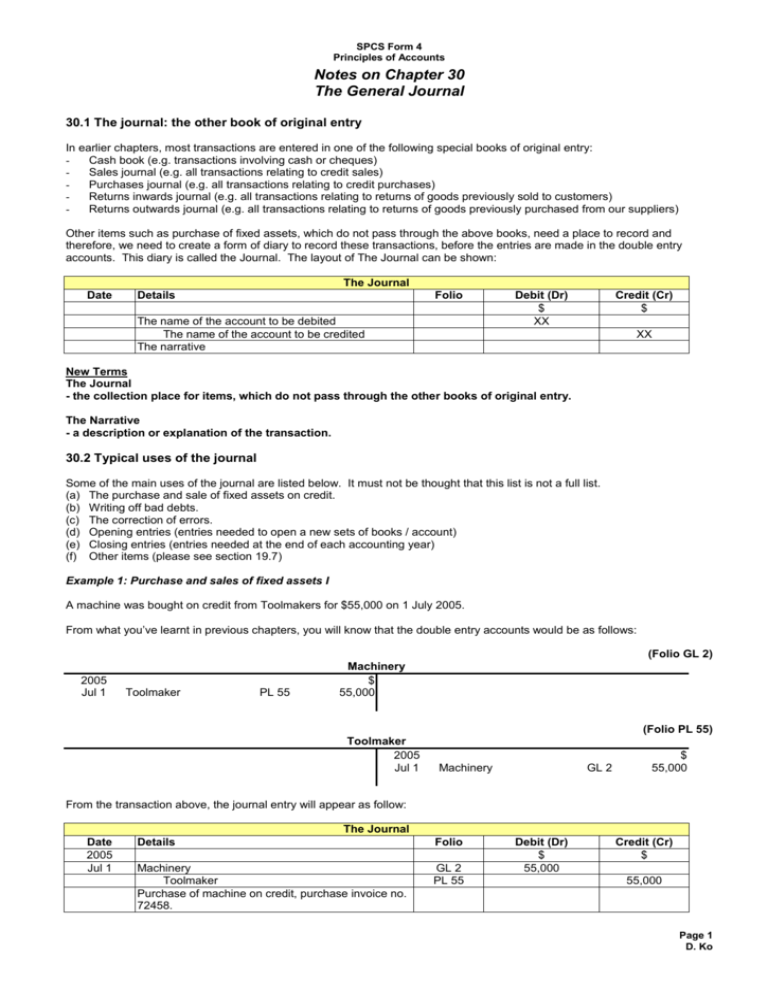
SPCS Form 4 Principles of Accounts Notes on Chapter 30 The General Journal 30.1 The journal: the other book of original entry In earlier chapters, most transactions are entered in one of the following special books of original entry: Cash book (e.g. transactions involving cash or cheques) Sales journal (e.g. all transactions relating to credit sales) Purchases journal (e.g. all transactions relating to credit purchases) Returns inwards journal (e.g. all transactions relating to returns of goods previously sold to customers) Returns outwards journal (e.g. all transactions relating to returns of goods previously purchased from our suppliers) Other items such as purchase of fixed assets, which do not pass through the above books, need a place to record and therefore, we need to create a form of diary to record these transactions, before the entries are made in the double entry accounts. This diary is called the Journal. The layout of The Journal can be shown: The Journal Date Details Folio The name of the account to be debited The name of the account to be credited The narrative Debit (Dr) $ XX Credit (Cr) $ XX New Terms The Journal - the collection place for items, which do not pass through the other books of original entry. The Narrative - a description or explanation of the transaction. 30.2 Typical uses of the journal Some of the main uses of the journal are listed below. It must not be thought that this list is not a full list. (a) The purchase and sale of fixed assets on credit. (b) Writing off bad debts. (c) The correction of errors. (d) Opening entries (entries needed to open a new sets of books / account) (e) Closing entries (entries needed at the end of each accounting year) (f) Other items (please see section 19.7) Example 1: Purchase and sales of fixed assets I A machine was bought on credit from Toolmakers for $55,000 on 1 July 2005. From what you’ve learnt in previous chapters, you will know that the double entry accounts would be as follows: (Folio GL 2) 2005 Jul 1 Toolmaker PL 55 Machinery $ 55,000 (Folio PL 55) Toolmaker 2005 Jul 1 Machinery GL 2 $ 55,000 From the transaction above, the journal entry will appear as follow: The Journal Date 2005 Jul 1 Details Folio Machinery Toolmaker Purchase of machine on credit, purchase invoice no. 72458. GL 2 PL 55 Debit (Dr) $ 55,000 Credit (Cr) $ 55,000 Page 1 D. Ko SPCS Form 4 Principles of Accounts Example 2: Purchase and sales of fixed assets II Sale of stationery not needed for $3000 on credit to K. Kan on 2 July 2005. Again, entries needed in the double entry accounts are as follows: (Folio SL 79) 2005 Jul 2 Stationery GL 51 K, Kan $ 3000 (Folio GL 51) Stationery 2005 Jul 2 K. Kan $ 3000 SL 79 Once again, the transactions are shown in journal form as follows: The Journal Date 2005 Jul 2 Details Folio K. Kan Stationery Sale of stationery not needed SL 79 GL 51 Debit (Dr) $ 3000 Credit (Cr) $ 3000 Example 3: Writing off bad debts A debt of $780 owing to us from H. Man was written off as a bad debt on 31 August 2005. In double entry form, this is shown as: (Folio GL 16) 2005 Aug 31 H. Man SL 99 Bad Debts $ 780 (Folio SL 99) 2005 Aug 1 Balance b/f H. Man 2005 780 Aug 31 Bad debts $ 780 GL 16 Once again, the transactions are shown in journal form as follows: The Journal Date 2005 Aug 31 Details Folio Bad debts H. Man Debt written off as bad. See letter in file 7/89006 GL 16 SL 99 Debit (Dr) $ 780 Credit (Cr) $ 780 Example 4: Opening entries S. Lee, after being in business for some years without keeping a proper set of records, has now decided to keep a double entry set of books. On 1 July 2006, his assets and liabilities are as follows: Assets: Motor van $840, fixtures $700, stock $390, debtors – T. Lok $95, C, Chin $45, bank $80, cash $20. Liabilities: Creditors – M. Lee $129, H, Sung $41. The assets therefore total $2,170; and the liabilities total $170. The capital consists of assets – liabilities = $2,170 – 170 = $2,000 Page 2 D. Ko SPCS Form 4 Principles of Accounts The opening entries in The Journal, will appear as follows: (Page 1) The Journal Date 2006 Jul 1 Details Folio Motor van Fixtures Stock Debtors – T. Lok – C . Chin Bank Cash Creditors – M. Lee – H. Sung Capital Assets, liabilities and capital at this date entered to open the books. / Opening entries as at 1 Jul. 2006 Debit (Dr) Credit (Cr) $ 840 700 390 95 45 80 20 GL 1 GL 2 GL 3 SL 1 SL 2 CB 1 CB 1 PL 1 PL 2 GL 4 $ 129 41 2,000 Example 5: Closing entries At the end of an accounting year, when the various expense and revenue items are transferred to the trading account or the profit and loss account, entries in respect of each transfer should be made in The Journal. Collectively these entries are known as the closing entries, as they close off the accounts as at the end of the accounting year. To illustrate closing entries, we will take four items out of a much larger number of items needing closing entries. These are: Folio GL 27 GL 49 GL 45 GL 66 Sales Carriage inwards Rent expense Discounts received $ 295,600 3,450 7,700 6,470 Dr / Cr Cr Dr Dr Cr The final accounts are shown in the general ledger – folio GL 33. The final accounts are for the year ended 31 December 2005. The journal entries will therefore appear as: (page 22) The Journal Date 2005 Dec 31 Dec 31 Dec 31 Dec 31 Details Sales Trading account Transfer of sales to trading account Trading account Carriage inwards Transfer of carriage inwards to trading account Profit and loss account Rent expense Transfer of rent expense to profit and loss account Discounts received Profit and loss account Transfer of discounts received to profit and loss account. Folio GL 27 GL 33 Debit (Dr) Credit (Cr) $ 295,600 $ 295,600 GL 33 GL 49 3,450 GL 33 GL 45 7,700 GL 66 GL 33 6,470 3,450 7,700 6,470 30.3 Other closing entries In addition to the above, items such as drawings and net profit (or net loss) that need transferring to the capital account should also be entered in The Journal. Drawings needed to be transferred to the capital account would be shown as: Debit: Capital account Credit: Drawings account When the net profit figure has been calculated, the entry in The Journal should be: Debit: Profit and Loss account Credit: Capital account Page 3 D. Ko SPCS Form 4 Principles of Accounts 30.4 Other items Example 6: Offer of a fixed asset in settlement of a debt K. Young, a debtor, owed $22,000 on 1 July 2006. He was unable to pay his account in cash, but offered a motor vehicle in full settlement of the debt. The offer was accepted on 5 July 2006. The entries in The Journal is shown as follows: The Journal Date 2006 Jul 5 Details Folio Motor vehicle K. Young Accepted motor vehicle in full settlement of the debt as per letter dated 5 Jul 2006. GL 177 SL 334 Debit (Dr) Credit (Cr) $ 22,000 $ 22,000 Example 7: Transfer of indebtedness T. Fung is a creditor. On 10 July 2006, his business was taken over by A. Lee to whom the debt $15,000 now is to be paid. Here, just one creditor is being exchanged for another. The action needed is to cancel the amount owing to T. Fung by debiting his account, and to show it owing to A. Lee by opening an account for A. Lee and crediting it. The entries in The Journal is shown as follows: The Journal Date 2006 Jul 10 Details T. Fung A. Lee Transfer of indebtedness as per letter ref. G/3458 Folio SL 92 SL 268 Debit (Dr) $ 15,000 Credit (Cr) $ 15,000 30.5 Exercises (please refer to handout provided) Page 4 D. Ko
